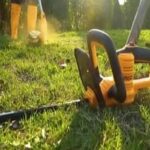As an Amazon Associate, this site earns commissions from qualifying purchases. For more information click here.
If you recently bought a chainsaw, one of the first questions that probably popped up is, does this thing need warm up? Or can you just use it right away? In this post you are going to find out the answer and also the best practices you should follow. As you will see, it depends on what type of chainsaw you use.
Gas powered chainsaws require a warm up to lubricate the engine components. When you start a chainsaw and let it sit idle for a minute, it provides enough time for the oil to coat the pistons, bearings and other parts. Electric and battery powered chainsaws do not require idling time.
Why You Should Warm Up Your Chainsaw
It is true that you can use a gas chainsaw without warming up. However you will get better results if you do.
By idling up your chainsaw, you allow the oil to thin and spread throughout the engine. A well lubricated engine will always run better and make your work easier.
If you want to cut several chunks of wet wood your chainsaw must be at maximum power. With sufficient warm up it can handle the higher revs without any trouble. Another benefit is it optimizes the performance of the air and fuel mix.
The few seconds you take to warm it up can make a huge difference in terms of performance and longevity .If you have a new chainsaw and want to get the most out of it, this will definitely help.

A chainsaw engine is made up of many parts. To run efficiently, these components must be well lubricated.
Warming up ensures the oil reaches the piston, bearings and other parts. A well lubricated engine will always perform better than one that is not. This benefit is for both short and long term. Lubrication reduces wear and tear so you can use the chainsaw longer. A high quality chainsaw like the Poulan Pro 20 in is going to last even longer when warmed up.
If you use your chainsaw a lot, this can make huge difference in performance and reliability. Inside the engine, the oil keeps the temperature even. It also stabilizes the fuel to air ratio.
How to Start and Warm up a Chainsaw
Simply start your gas powered chainsaw and let it idle for at least 30 seconds up to a minute. The smaller the engine, the shorter the warm up time needed.
Before you start a chainsaw, put on protective gear. Work gloves, steel toe boots, safety goggles, ear protection and a hard hat.
Step 1. Set the chain brake. Pace the chainsaw on an even surface. To engage the brake push it forward.
Step 2. Set the choke control to on. Pull the choke / start control if you chainsaw comes with a decompression valve, push it.
Step 3. Prime the engine. You may have to press the prim button repeatedly. Usually it takes half a dozen presses.
Step 4. Pull the starter. Use your strong foot on the rear handle and your strong hand on the front handle. Pull with your hand until the engine starts.
Step 5. Start the chainsaw. Push the choke and that will start the saw. To disengage the idling, squeeze the throttle. When you are done cutting, turn it off via the off button or ignition switch.
Once your chainsaw is on, let it idle. Again, the warm up time is up to you. The minimum however should be 30 seconds, and one minute is sufficient for most models.
Do All Chainsaws Need Warm Ups?
Only gas chainsaws need warming up. Electric and battery run chainsaws do not. Electric and battery operated models do not have a gas / oil engine so idling is not needed. The 18 inch Oregon CS1500 chainsaw for instance, does not need any warming up.
That being said there are things you can do to improve performance and usability of electric and battery run chainsaws. There are a lot of models available but the following is applicable to all of them.
Electric and Battery Powered Chainsaws
Keep in mind battery and electric chainsaws can only be used for light cutting. Use a gas chainsaw if you have to cut trees or several large pieces of wood.
Electric chainsaws get hot during and after use. This is to be expected because its motor is running. Turn off your electric chainsaw if it gets too hot. These are not meant for continuous work so take breaks.
This also applies to battery operated saws. They are less expensive and portable, but their capacity is limited.
Bottom line: if you only need to cut small branches and wood, electric or battery saws will suffice. If you have to do heavy duty work, a gas chainsaw is better.
Gas Powered Chainsaws
Gas chainsaws are more powerful and also more complex. Warming up allows the oil to do its work on the engine.
Idling chainsaws does not waste fuel. On the contrary, it improves performance and efficiency. By letting the oil get to the essential parts, you make it easier for the saw to work.
The more efficient a chainsaw is, the less strain on its components. You will be able to use it for a longer time and save dollars.
Put it simply, warming can prolong engine life. Not doing so accelerates wear and tear. Running any engine without sufficient lubrication will get wear out the components quickly.
Does Engine Type Affect Warm Up?
Most chainsaws are 2-stroke (2 cycle), but 4-stroke (4 cycle) models are also available mostly for commercial use.
2-stroke engines need less warm up time than a 4-stroke. The reason is 4-stroke engines keep oil and gas apart, so lubrication takes more time.
A 2-stroke chainsaw engine on the other hand, will only run if gas and oil are mixed. The gas and oil mix ratio is usually 50:1.
How to Start a Chainsaw in Cold Weather
First, wear the appropriate PPE for winter. A chainsaw is only as good as its operator so make sure you are wearing the right gear – gloves, jacket etc. – before you start. Wood tends to splinter a lot more in a dry, cold atmosphere so protect yourself at all times.
If your chainsaw has a carburetor shutter, switch it now to winter. If you are still having trouble, bring the chainsaw indoors so you can start it at room temperature.
Using chainsaws in winter requires additional maintenance. Follow these tips to keep it running smoothly regardless of the temperature.
A thorough cleaning. Remove sawdust and other debris from the sprocket cover, sprocket cover and chain groove. Frozen wood is harder to cut and requires more power, so a clean chainsaw is necessary for this kind of work.
Check the spark plug and air filter. If necessary replace them both. All the work you did during summer has probably clogged the filter. Clean it thoroughly or get a new one.
Some brands offer specialized winter air filters which you may want to check out. If you do a lot of work in the cold, a cover for the starter house is a good idea too.
Use the right oil. You have to use winter grad oil to get the best results. Consult your product manual for recommendations. Use a winter grade lubricant or add 5-10% kerosene to the mix.
Constant temperature is essential for winter grade fuel. Once it is ready, keep it in the cold. Moving it back and forth between cold and warm temperatures will alter the mix and affect performance.
Use the right chain. A chipper or semi-chisel saw chain is ideal for cutting frozen wood. The rounded shape allows the chain to better retain its sharpness. When sharpening, reduce by five degrees the top filling angle. A carbide tip chain is the best for wood cutting in 10 F or lower temperature.
This changes the aggressiveness of the cutting angle but also cuts back on wear and tear. Adjusting the filing angle also minimizes vibration and allows the chainsaw to maintain its edge even when cutting hard, frozen wood.

I love the outdoors and all the tools for maintaining gardens, yards and lawns. The only thing I am more passionate about is sharing what I know about garden and outdoor equipment.


